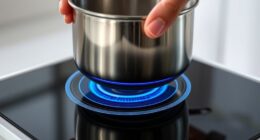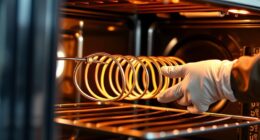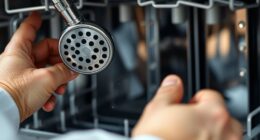As we explore the realm of appliance power, let’s address a common question: do appliances operate on AC or DC?
In this article, we’ll unravel the mystery and explore the ins and outs of electrical currents. We’ll compare the advantages of AC and DC power, delve into their impact on energy efficiency, and contemplate the future of appliance power.
Join us on this enlightening journey as we empower you with the knowledge to confidently power your appliances.
Key Takeaways
- Appliances in most households run on AC current.
- DC current is commonly used in smaller electronic devices.
- Converting AC to DC or vice versa can affect appliance efficiency.
- Alternative power sources like solar panels and batteries often generate or store DC power, which is used by appliances directly utilizing these sources.
Understanding AC and DC
To understand whether appliances run on AC or DC, it’s important to grasp the fundamental differences between the two types of electrical currents.
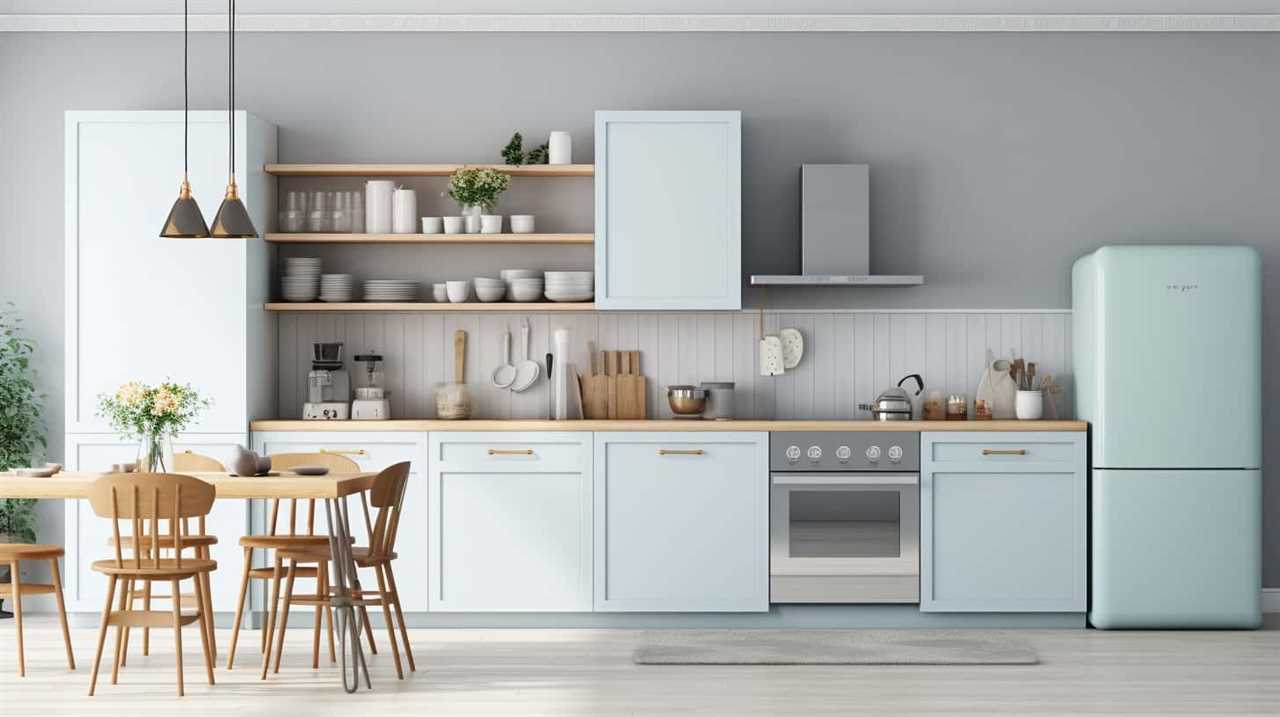
AC, or alternating current, is characterized by its continuous and periodic change in direction. It’s commonly used in household appliances and electrical grids.
On the other hand, DC, or direct current, flows continuously in one direction. Understanding electrical circuits is crucial in comprehending the comparison of voltage sources. AC voltage sources, such as power outlets, provide a sinusoidal waveform, while DC voltage sources, like batteries, supply a constant voltage.
This distinction in voltage sources affects the behavior of appliances and the efficiency of electrical systems. Now that we’ve a basic understanding of AC and DC, let’s delve into the difference between the two.
The Difference Between AC and DC
When it comes to electricity, understanding the difference between AC and DC is crucial. AC, or alternating current, constantly changes direction, while DC, or direct current, flows in only one direction. This fundamental distinction has significant implications for the operation and application of electrical devices.

AC Vs DC Basics
We prefer using AC over DC because it allows us to easily transmit electricity over long distances. Understanding electrical currents is essential in comparing AC and DC.
AC stands for alternating current, where the flow of electric charge periodically reverses direction. This type of current is used in most household appliances and electrical power distribution systems.
On the other hand, DC, or direct current, flows in only one direction. It’s commonly used in batteries and electronic devices.
AC has the advantage of being easily converted to different voltage levels using transformers, making it suitable for long-distance transmission. DC, on the other hand, is more efficient for powering electronic devices directly.

Both AC and DC have their specific applications, and understanding their differences is crucial for mastering electrical systems.
Applications of AC/DC
In our discussion of the applications of AC/DC and the difference between AC and DC, it’s important to understand the various ways in which these electrical currents are utilized. AC and DC currents have different characteristics that make them suitable for specific applications.
Applications of AC:
- Power transmission: AC is used for long-distance power transmission due to its ability to travel over large distances with minimal energy loss.
- Home appliances: AC is the standard current used in most household appliances, such as refrigerators, air conditioners, and televisions.
Applications of DC:

- Electronics: DC is commonly used in electronic devices, such as computers, smartphones, and batteries.
- Renewable energy: DC is used in solar panels and wind turbines to convert and store energy.
When considering energy consumption and safety measures, it’s important to choose the appropriate current for each application.
Now, let’s explore the various aspects of electrical currents in more detail.
Exploring Electrical Currents
Let’s now explore the topic of electrical currents and how they relate to the usage of AC and DC.
Understanding the basics of electrical currents is crucial in comprehending the difference between these two types of currents and their applications in various electrical devices.

AC Vs. DC Usage
Most appliances in our homes are designed to run on alternating current (AC) rather than direct current (DC). AC power has several advantages over DC power, making it the preferred choice for residential applications.
- AC vs. DC efficiency:
- AC power can be transmitted over long distances with minimal losses, thanks to the ability to step up and step down the voltage using transformers. DC power, on the other hand, suffers from higher transmission losses.
- AC motors are more efficient than DC motors when it comes to converting electrical energy into mechanical energy. This is why most household appliances, such as refrigerators and washing machines, use AC motors.
- Advantages of AC power:
- AC power can be easily converted to different voltages using transformers, allowing for efficient distribution and utilization.
- AC power can be generated using various sources, including fossil fuels, nuclear energy, and renewable sources like solar and wind power.
Electrical Current Basics
We explore the basics of electrical currents and their significance in powering our appliances. Understanding electrical currents is essential in exploring electrical circuits and ensuring proper voltage regulation.
Electrical current refers to the flow of electric charge in a circuit, and it’s measured in amperes (A). Current flows from a high potential (voltage) to a low potential, creating a closed loop.
In direct current (DC), the flow of charge is constant and in one direction, while in alternating current (AC), the flow of charge periodically changes direction. AC is the standard for home and industrial electricity, while DC is commonly used in batteries and electronic devices.

Mastering the concepts of electrical currents is crucial for designing and maintaining efficient and safe electrical systems.
Unraveling the Mystery of Appliance Power
Appliance power can be better understood by examining the source of energy they rely on and how it’s converted for their operation. Understanding this process is crucial for optimizing appliance power efficiency and ensuring optimal performance.
Here are two key factors to consider:
- Power Source: The type of power source, whether it’s alternating current (AC) or direct current (DC), can have a significant impact on appliance performance. AC power is the standard in most homes and businesses, but some appliances, such as laptops and smartphones, rely on DC power. Converting AC to DC or vice versa can introduce inefficiencies and affect overall appliance power efficiency.
- Conversion Process: Appliances often require energy conversion to function properly. This conversion can involve steps like voltage transformation, rectification, or inversion. Each conversion step introduces some energy loss, which can impact the overall efficiency of the appliance. Understanding the conversion process and minimizing energy losses can help improve appliance performance and reduce energy consumption.
AC Vs. DC: Which Is More Common
When it comes to the power sources of appliances, AC and DC currents are the two main options. In terms of popularity, AC current is more common in household appliances. This is because AC current is easier to generate, transmit, and distribute over long distances, making it the preferred choice for powering appliances in most homes.

Appliance Power Sources
Are appliances typically powered by AC or DC?
Most appliances in our homes are powered by AC (alternating current), which is the standard power supplied by the electrical grid. However, there are some appliances, especially smaller electronic devices, that are powered by DC (direct current).
When it comes to appliance power efficiency, AC is generally more efficient than DC. AC power can be easily distributed over long distances without significant power loss, making it more suitable for powering large appliances. On the other hand, DC power is more efficient for small electronic devices because it doesn’t require conversion from AC to DC, reducing power loss.
Alternative power sources, such as solar panels and batteries, often generate or store DC power. Therefore, appliances that directly utilize these alternative power sources often operate on DC power. It’s important to note that some appliances have the capability to operate on both AC and DC power, allowing for flexibility in power sources.
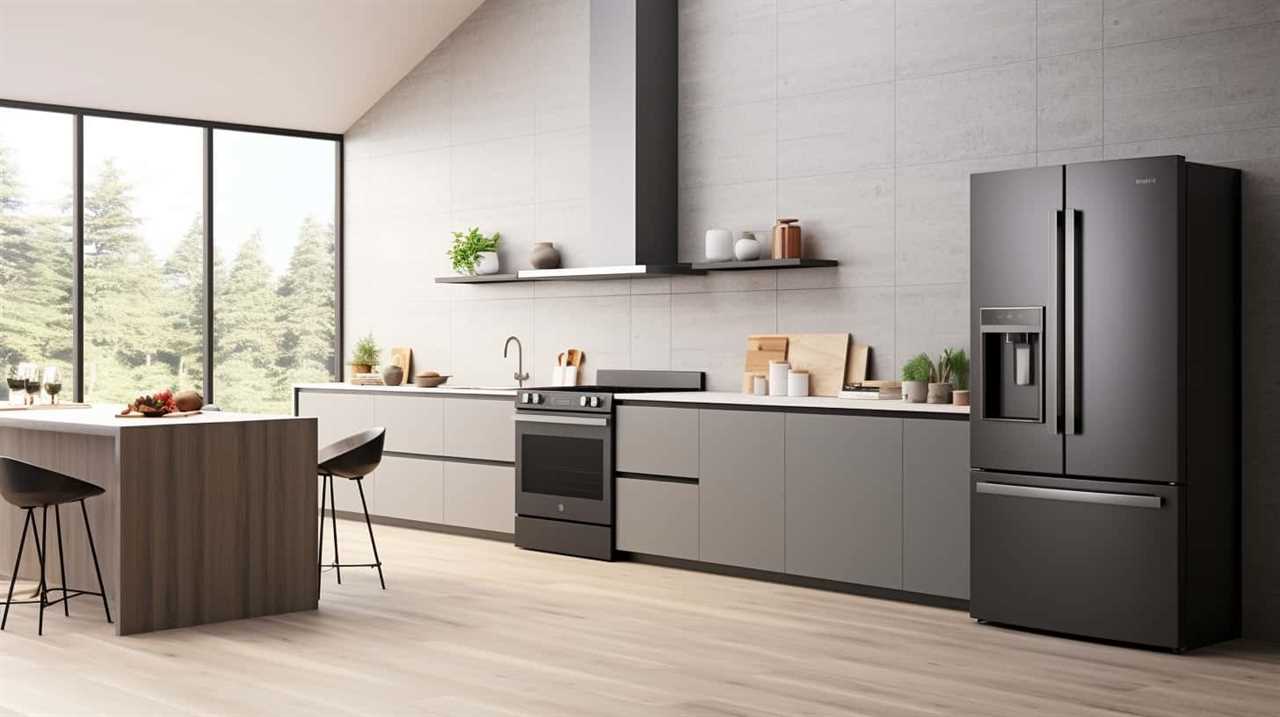
Popularity of Electrical Currents
The prevalence of electrical currents in homes and buildings is influenced by the popularity of AC and DC power sources.
AC, or alternating current, is the most common type of electrical current used in homes and buildings worldwide. This is primarily due to the advantages it offers, such as its ability to be easily generated, transmitted, and distributed over long distances. Additionally, AC power is more efficient for running appliances and devices, which is why it’s the preferred choice for residential and commercial applications.
On the other hand, DC, or direct current, is mainly used in specific applications where a constant and steady flow of electricity is required, such as in batteries and electronic devices. While DC power has its own advantages, its popularity is limited compared to AC due to the impact on energy consumption.
Understanding the popularity of these two electrical currents is essential to comprehend the role of transformers in power supply, which we’ll explore in the next section.

The Role of Transformers in Power Supply
Transformers play a crucial role in supplying power to appliances. They’re essential devices that help convert voltage levels to match the requirements of various electrical devices. The importance of voltage conversion can’t be overstated, as it ensures that appliances receive the correct amount of power to operate efficiently and safely.
Here are two key aspects of the role of transformers in power supply:
- Voltage Regulation:
- Transformers help regulate voltage by stepping it up or down, depending on the needs of the appliances.
- They increase voltage for long-distance power transmission to minimize power loss.
- Isolation:
- Transformers provide electrical isolation between the power source and the appliance, protecting users from electric shock.
- They prevent the transfer of high voltages and currents to the appliance, enhancing safety.
How Appliances Convert AC to DC
Now let’s explore how appliances convert AC to DC, addressing the question of how they accomplish this important task.
Appliance power conversion involves the use of electrical circuits to transform the alternating current (AC) supplied by the power source into direct current (DC) that the appliance can utilize.

To achieve this conversion, appliances typically employ a component called a rectifier. The rectifier is responsible for converting the AC signal into a pulsating DC signal by allowing the flow of current in only one direction.
This pulsating DC signal is then smoothed out using a filter or capacitor to produce a stable DC voltage.
The understanding of electrical circuits is crucial in designing and implementing efficient power conversion systems in appliances, ensuring the safe and reliable operation of various household devices.
The Advantages of AC Power
When it comes to appliances, we prefer AC power for its numerous advantages. AC power, or alternating current, has several benefits that make it the preferred choice for powering our devices. Here are some advantages of AC power:

- Higher Efficiency: AC power is more efficient than DC power, especially for long-distance transmission. This is because AC can be easily stepped up or down using transformers, reducing energy losses during transmission.
- Compatibility: AC power is compatible with a wide range of appliances and devices. It can be easily converted to DC power using power adapters, making it suitable for various applications.
- Safety: AC power is safer to use as it has a lower risk of electric shock. AC power periodically changes direction, reducing the likelihood of sustained contact with live wires.
Now let’s explore the advantages of DC power, which has its own unique set of benefits.
The Advantages of DC Power
Moving on to the advantages of DC power, we can see that it offers its own unique set of benefits.
DC power, especially when used in conjunction with renewable energy sources, provides several advantages over AC power.
One of the key benefits of using DC power is its higher energy efficiency compared to AC power. DC power allows for a more direct flow of energy, minimizing the energy losses that occur during conversion.

Additionally, DC power systems are often more compact and require fewer components, resulting in reduced installation and maintenance costs.
Furthermore, DC power can be easily stored in batteries, allowing for greater flexibility and reliability in power supply.
Overall, these advantages make DC power an attractive option for harnessing the benefits of renewable energy sources.
Now, let’s explore the impact of AC and DC on energy efficiency.

The Impact of AC and DC on Energy Efficiency
Based on the advantages of DC power discussed earlier, we can see that it offers a higher energy efficiency compared to AC power. This higher energy efficiency has a significant impact on appliances.
- Reduced Power Losses: DC power transmission experiences lower power losses compared to AC power transmission. This means that appliances running on DC power can operate more efficiently and consume less energy overall.
- No Need for Conversion: Appliances that run on DC power don’t require an AC to DC conversion, which can result in energy losses. This eliminates the need for external power adapters or converters and reduces energy consumption.
- Example: LED lights that run on DC power are more energy-efficient than those running on AC power, as they eliminate the need for AC to DC conversion.
The Future of Appliance Power: AC or DC
In the future, we will continue to see a shift towards utilizing either AC or DC power for appliances. As technology advances and renewable energy integration becomes more widespread, there will be a greater need for efficient and reliable power sources. This will drive future advancements in appliance power systems.
To better understand the future of appliance power, let’s take a look at the potential benefits and considerations of both AC and DC power:
| AC Power | DC Power |
|---|---|
| – Widely used in current infrastructure | – More efficient for certain applications |
| – Easier to convert voltages | – Compatible with renewable energy sources |
| – Supports long-distance transmission | – Suitable for low-power devices |
As we move forward, the choice between AC and DC power for appliances will depend on specific requirements and technological advancements. Both AC and DC have their own advantages and will likely coexist in the future, with AC continuing to dominate in existing infrastructure and DC gaining traction in newer applications.

Conclusion: Powering Your Appliances With Confidence
To confidently power our appliances, it’s important to consider the advantages and requirements of both AC and DC power. Understanding the powering techniques and their impact on energy consumption can help us make informed decisions. Here are some key considerations:
- AC Power:
- Advantages:
- Widely available and compatible with most appliances.
- Allows for long-distance transmission without significant power loss.
- Requirements:
- Requires a power grid or generator to convert AC power from its original source.
- Involves higher energy loss during conversion.
- DC Power:
- Advantages:
- Efficient for low-voltage devices, such as mobile phones and laptops.
- Enables renewable energy integration, as many sources generate DC power.
- Requirements:
- Requires additional equipment, like inverters, to convert from AC to DC power for certain appliances.
- Limited availability in public infrastructure, which may require personal setup.
Frequently Asked Questions
Can Appliances Designed for AC Power Be Safely Used With DC Power?
Yes, appliances designed for AC power can be safely used with DC power. However, it is important to consider the DC power compatibility of the specific appliance. Using DC power can offer advantages such as increased efficiency and reduced energy consumption.
How Do Appliances Determine Whether to Use AC or DC Power?
Appliance power requirements vary, but most appliances are designed to run on either AC or DC power. Voltage conversion for appliances is determined by the internal circuitry and power supply.
Are There Any Safety Concerns When Using AC or DC Power for Appliances?
Safety implications and compatibility issues arise when using AC or DC power for appliances. It is crucial to consider voltage requirements, insulation, grounding, and potential risks of electric shock or fire.

Can Appliances Designed for DC Power Be Easily Converted to Use AC Power?
Appliances designed for DC power cannot be easily converted to use AC power due to compatibility issues. The conversion process involves complex circuitry and may require modifications to the appliance’s internal components.
What Are the Limitations of Using AC or DC Power for Appliances?
Appliances can run on AC or DC power. Each has advantages and disadvantages. AC provides easier transmission over long distances and is suitable for most appliances. DC is more efficient for certain devices but requires conversion for widespread use.
Conclusion
In conclusion, after exploring the differences between AC and DC power and their impact on energy efficiency, it’s clear that DC power offers numerous advantages for appliances.
However, AC power remains more common in our current infrastructure.

Nevertheless, as we look towards the future, the potential shift towards DC power holds promise for increased efficiency and reduced environmental impact.
Embracing this change will empower us to confidently power our appliances and shape a more sustainable world.







